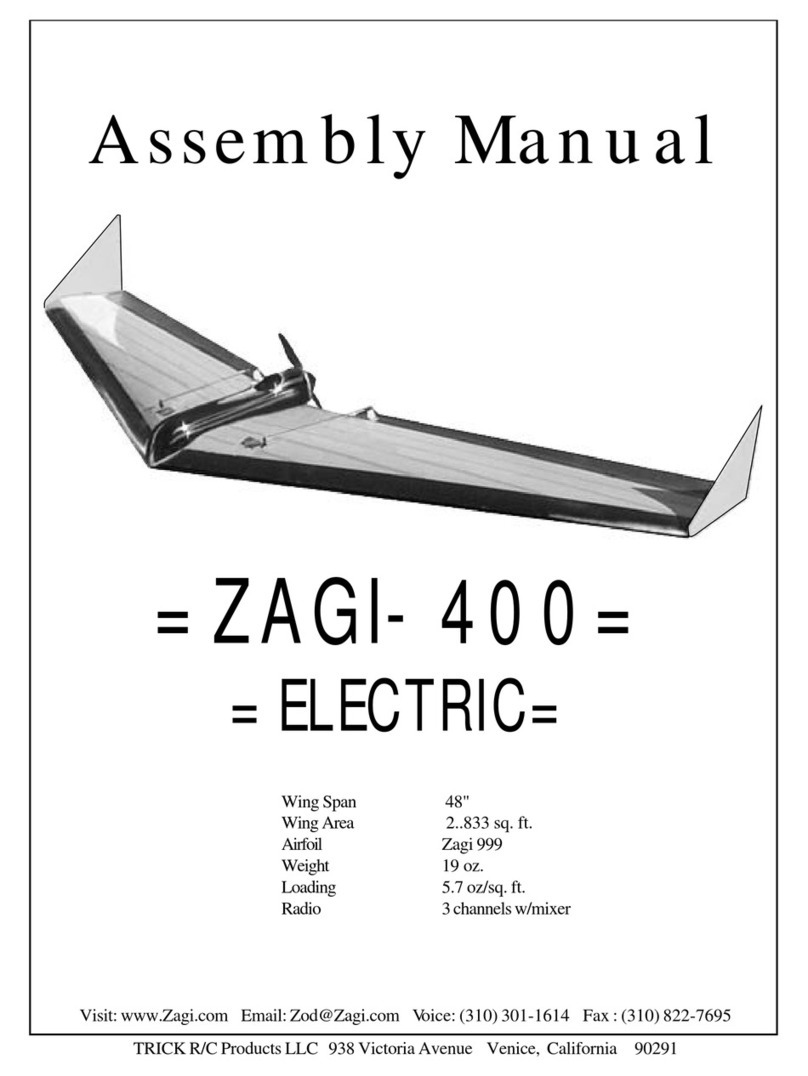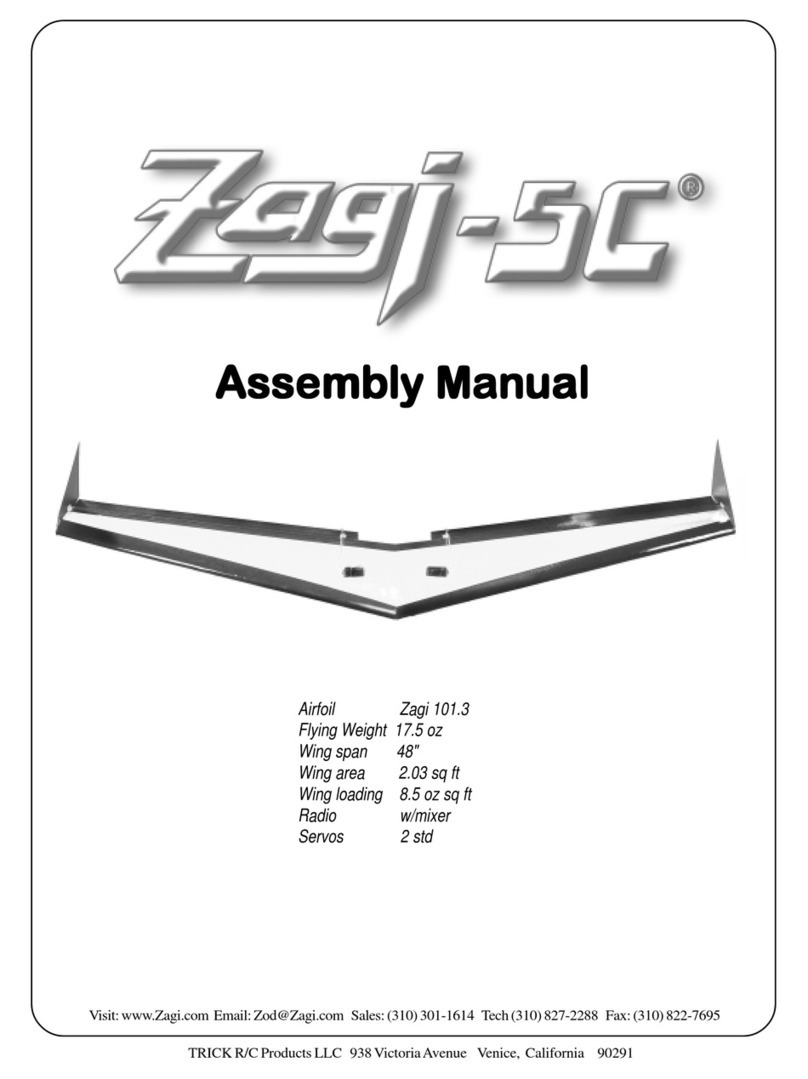
The ZAGI-400 X should be sprayed with #77 and covered with tape before any holes are
cut for radio installation. This will avoid getting spray adhesive in the radio compart-
ments or on the antenna. Most of the colors are transparent enough to see the servo
cutout marks through the tape. If a dark color tape is used, make some small impres-
sions with a pencil at the corners of the servo cutout marks.
(See Figure 4) Vacuum the dust from the cores, beds and the work bench. Lay the wing
in the bottom beds top-side up. Apply a light coat of
#77
to cover the top of the entire
wing. Allow the adhesive spray to dry at least 30 minutes. Repeat this procedure on the
other side. Let the adhesive dry for 30 minutes. Lay the wing top-side up in the bottom
beds. Wrap a strip of 3/4” fiber filament tape around the trailing edge between the wing
tip and the prop cutout. Apply a strip of fiber tape to the trailing edge from the wing tip to
the opposite leading edge.
page 5
Apply spanwise strips of tape
at the motor tray cutout extending
to the leading edge on both sides
(See Figure 5)
Apply another strip of 3/4’’ fiber tape in the center of the wing 4’’ from the motor tray
cutout. Apply two strips of fiber tape diagonally from the nose to the outboard tip of the trailing edge.
Lay the wing bottom-side up in the top beds and repeat the same taping procedure on the bottom side.
123456789012345678901234567890121234567890123456789012345678901212345678901234567890123456789
123456789012345678901234567890121234567890123456789012345678901212345678901234567890123456789
123456789012345678901234567890121234567890123456789012345678901212345678901234567890123456789
123456789012345678901234567890121234567890123456789012345678901212345678901234567890123456789
123456789012345678901234567890121234567890123456789012345678901212345678901234567890123456789
123456789012345678901234567890121234567890123456789012345678901212345678901234567890123456789
123456789012345678901234567890121234567890123456789012345678901212345678901234567890123456789
123456789012345678901234567890121234567890123456789012345678901212345678901234567890123456789
123456789012345678901234567890121234567890123456789012345678901212345678901234567890123456789
123456789012345678901234567890121234567890123456789012345678901212345678901234567890123456789
123456789012345678901234567890121234567890123456789012345678901212345678901234567890123456789
123456789012345678901234567890121234567890123456789012345678901212345678901234567890123456789
123456789012345678901234567890121234567890123456789012345678901212345678901234567890123456789
123456789012345678901234567890121234567890123456789012345678901212345678901234567890123456789
123456789012345678901234567890121234567890123456789012345678901212345678901234567890123456789
123456789012345678901234567890121234567890123456789012345678901212345678901234567890123456789
123456789012345678901234567890121234567890123456789012345678901212345678901234567890123456789
123456789012345678901234567890121234567890123456789012345678901212345678901234567890123456789
123456789012345678901234567890121234567890123456789012345678901212345678901234567890123456789
123456789012345678901234567890121234567890123456789012345678901212345678901234567890123456789
123456789012345678901234567890121234567890123456789012345678901212345678901234567890123456789
123456789012345678901234567890121234567890123456789012345678901212345678901234567890123456789
123456789012345678901234567890121234567890123456789012345678901212345678901234567890123456789
123456789012345678901234567890121234567890123456789012345678901212345678901234567890123456789
123456789012345678901234567890121234567890123456789012345678901212345678901234567890123456789
123456789012345678901234567890121234567890123456789012345678901212345678901234567890123456789
123456789012345678901234567890121234567890123456789012345678901212345678901234567890123456789
123456789012345678901234567890121234567890123456789012345678901212345678901234567890123456789
123456789012345678901234567890121234567890123456789012345678901212345678901234567890123456789
123456789012345678901234567890121234567890123456789012345678901212345678901234567890123456789
123456789012345678901234567890121234567890123456789012345678901212345678901234567890123456789
123456789012345678901234567890121234567890123456789012345678901212345678901234567890123456789
123456789012345678901234567890121234567890123456789012345678901212345678901234567890123456789
123456789012345678901234567890121234567890123456789012345678901212345678901234567890123456789
123456789012345678901234567890121234567890123456789012345678901212345678901234567890123456789
123456789012345678901234567890121234567890123456789012345678901212345678901234567890123456789
123456789012345678901234567890121234567890123456789012345678901212345678901234567890123456789
123456789012345678901234567890121234567890123456789012345678901212345678901234567890123456789
123456789012345678901234567890121234567890123456789012345678901212345678901234567890123456789
123456789012345678901234567890121234567890123456789012345678901212345678901234567890123456789
123456789012345678901234567890121234567890123456789012345678901212345678901234567890123456789
123456789012345678901234567890121234567890123456789012345678901212345678901234567890123456789
123456789012345678901234567890121234567890123456789012345678901212345678901234567890123456789
123456789012345678901234567890121234567890123456789012345678901212345678901234567890123456789
123456789012345678901234567890121234567890123456789012345678901212345678901234567890123456789
123456789012345678901234567890121234567890123456789012345678901212345678901234567890123456789
123456789012345678901234567890121234567890123456789012345678901212345678901234567890123456789
123456789012345678901234567890121234567890123456789012345678901212345678901234567890123456789
123456789012345678901234567890121234567890123456789012345678901212345678901234567890123456789
123456789012345678901234567890121234567890123456789012345678901212345678901234567890123456789
123456789012345678901234567890121234567890123456789012345678901212345678901234567890123456789
Figure 4
123456789012345678901234567890121234567890123456789012345678901212345678901234567890123456789012123456789012
1
2345678901234567890123456789012123456789012345678901234567890121234567890123456789012345678901212345678901
2
123456789012345678901234567890121234567890123456789012345678901212345678901234567890123456789012123456789012
Wrap fiber filament tape
around the trailing edge
Apply spanwise strips of tape in the
center of the wing 4’’ from
the motor tray cutout
Apply strips of fiber
tape diagonally from the nose to the
outboard tip of the trailing edge
4”
123456789012345678901234567890121234567890123456789012345678901212345678901234567890123456789
123456789012345678901234567890121234567890123456789012345678901212345678901234567890123456789
123456789012345678901234567890121234567890123456789012345678901212345678901234567890123456789
123456789012345678901234567890121234567890123456789012345678901212345678901234567890123456789
123456789012345678901234567890121234567890123456789012345678901212345678901234567890123456789
123456789012345678901234567890121234567890123456789012345678901212345678901234567890123456789
123456789012345678901234567890121234567890123456789012345678901212345678901234567890123456789
123456789012345678901234567890121234567890123456789012345678901212345678901234567890123456789
123456789012345678901234567890121234567890123456789012345678901212345678901234567890123456789
123456789012345678901234567890121234567890123456789012345678901212345678901234567890123456789
123456789012345678901234567890121234567890123456789012345678901212345678901234567890123456789
123456789012345678901234567890121234567890123456789012345678901212345678901234567890123456789
123456789012345678901234567890121234567890123456789012345678901212345678901234567890123456789
123456789012345678901234567890121234567890123456789012345678901212345678901234567890123456789
123456789012345678901234567890121234567890123456789012345678901212345678901234567890123456789
123456789012345678901234567890121234567890123456789012345678901212345678901234567890123456789
123456789012345678901234567890121234567890123456789012345678901212345678901234567890123456789
123456789012345678901234567890121234567890123456789012345678901212345678901234567890123456789
123456789012345678901234567890121234567890123456789012345678901212345678901234567890123456789
123456789012345678901234567890121234567890123456789012345678901212345678901234567890123456789
123456789012345678901234567890121234567890123456789012345678901212345678901234567890123456789
123456789012345678901234567890121234567890123456789012345678901212345678901234567890123456789
123456789012345678901234567890121234567890123456789012345678901212345678901234567890123456789
123456789012345678901234567890121234567890123456789012345678901212345678901234567890123456789
123456789012345678901234567890121234567890123456789012345678901212345678901234567890123456789
123456789012345678901234567890121234567890123456789012345678901212345678901234567890123456789
123456789012345678901234567890121234567890123456789012345678901212345678901234567890123456789
123456789012345678901234567890121234567890123456789012345678901212345678901234567890123456789
123456789012345678901234567890121234567890123456789012345678901212345678901234567890123456789
123456789012345678901234567890121234567890123456789012345678901212345678901234567890123456789
123456789012345678901234567890121234567890123456789012345678901212345678901234567890123456789
123456789012345678901234567890121234567890123456789012345678901212345678901234567890123456789
123456789012345678901234567890121234567890123456789012345678901212345678901234567890123456789
123456789012345678901234567890121234567890123456789012345678901212345678901234567890123456789
123456789012345678901234567890121234567890123456789012345678901212345678901234567890123456789
123456789012345678901234567890121234567890123456789012345678901212345678901234567890123456789
123456789012345678901234567890121234567890123456789012345678901212345678901234567890123456789
123456789012345678901234567890121234567890123456789012345678901212345678901234567890123456789
123456789012345678901234567890121234567890123456789012345678901212345678901234567890123456789
123456789012345678901234567890121234567890123456789012345678901212345678901234567890123456789
123456789012345678901234567890121234567890123456789012345678901212345678901234567890123456789
123456789012345678901234567890121234567890123456789012345678901212345678901234567890123456789
123456789012345678901234567890121234567890123456789012345678901212345678901234567890123456789
123456789012345678901234567890121234567890123456789012345678901212345678901234567890123456789
123456789012345678901234567890121234567890123456789012345678901212345678901234567890123456789
123456789012345678901234567890121234567890123456789012345678901212345678901234567890123456789
123456789012345678901234567890121234567890123456789012345678901212345678901234567890123456789
123456789012345678901234567890121234567890123456789012345678901212345678901234567890123456789
123456789012345678901234567890121234567890123456789012345678901212345678901234567890123456789
123456789012345678901234567890121234567890123456789012345678901212345678901234567890123456789
123456789012345678901234567890121234567890123456789012345678901212345678901234567890123456789
123456789012345678901234567890121234567890123456789012345678901212345678901234567890123456789
Figure 5
1234567890123456789012345678901212345678901234567890123456789
1234567890123456789012345678901212345678901234567890123456789
1234567890123456789012345678901212345678901234567890123456789
1234567890123456789012345678901212345678901234567890123456789
1234567890123456789012345678901212345678901234567890123456789
1234567890123456789012345678901212345678901234567890123456789
1234567890123456789012345678901212345678901234567890123456789
1234567890123456789012345678901212345678901234567890123456789
1234567890123456789012345678901212345678901234567890123456789
1234567890123456789012345678901212345678901234567890123456789
1234567890123456789012345678901212345678901234567890123456789
1234567890123456789012345678901212345678901234567890123456789
1234567890123456789012345678901212345678901234567890123456789
1234567890123456789012345678901212345678901234567890123456789
1234567890123456789012345678901212345678901234567890123456789
1234567890123456789012345678901212345678901234567890123456789
1234567890123456789012345678901212345678901234567890123456789
1234567890123456789012345678901212345678901234567890123456789
1234567890123456789012345678901212345678901234567890123456789
1234567890123456789012345678901212345678901234567890123456789
1234567890123456789012345678901212345678901234567890123456789
1234567890123456789012345678901212345678901234567890123456789
1234567890123456789012345678901212345678901234567890123456789
1234567890123456789012345678901212345678901234567890123456789
1234567890123456789012345678901212345678901234567890123456789
1234567890123456789012345678901212345678901234567890123456789
1234567890123456789012345678901212345678901234567890123456789
1234567890123456789012345678901212345678901234567890123456789
1234567890123456789012345678901212345678901234567890123456789
1234567890123456789012345678901212345678901234567890123456789
1234567890123456789012345678901212345678901234567890123456789
1234567890123456789012345678901212345678901234567890123456789
1234567890123456789012345678901212345678901234567890123456789
1234567890123456789012345678901212345678901234567890123456789
1234567890123456789012345678901212345678901234567890123456789
1234567890123456789012345678901212345678901234567890123456789
1234567890123456789012345678901212345678901234567890123456789
1234567890123456789012345678901212345678901234567890123456789
1234567890123456789012345678901212345678901234567890123456789
1234567890123456789012345678901212345678901234567890123456789
1234567890123456789012345678901212345678901234567890123456789
1234567890123456789012345678901212345678901234567890123456789
1234567890123456789012345678901212345678901234567890123456789
1234567890123456789012345678901212345678901234567890123456789
1234567890123456789012345678901212345678901234567890123456789
1234567890123456789012345678901212345678901234567890123456789
123456789012345678901234567890121234567890123456789012345678901
123456789012345678901234567890121234567890123456789012345678901
123456789012345678901234567890121234567890123456789012345678901
123456789012345678901234567890121234567890123456789012345678901
123456789012345678901234567890121234567890123456789012345678901
123456789012345678901234567890121234567890123456789012345678901
123456789012345678901234567890121234567890123456789012345678901
123456789012345678901234567890121234567890123456789012345678901
123456789012345678901234567890121234567890123456789012345678901
123456789012345678901234567890121234567890123456789012345678901
123456789012345678901234567890121234567890123456789012345678901
123456789012345678901234567890121234567890123456789012345678901
123456789012345678901234567890121234567890123456789012345678901
123456789012345678901234567890121234567890123456789012345678901
123456789012345678901234567890121234567890123456789012345678901
123456789012345678901234567890121234567890123456789012345678901
123456789012345678901234567890121234567890123456789012345678901
123456789012345678901234567890121234567890123456789012345678901
123456789012345678901234567890121234567890123456789012345678901
123456789012345678901234567890121234567890123456789012345678901
123456789012345678901234567890121234567890123456789012345678901
123456789012345678901234567890121234567890123456789012345678901
123456789012345678901234567890121234567890123456789012345678901
123456789012345678901234567890121234567890123456789012345678901
123456789012345678901234567890121234567890123456789012345678901
123456789012345678901234567890121234567890123456789012345678901
123456789012345678901234567890121234567890123456789012345678901
123456789012345678901234567890121234567890123456789012345678901
123456789012345678901234567890121234567890123456789012345678901
123456789012345678901234567890121234567890123456789012345678901
123456789012345678901234567890121234567890123456789012345678901
123456789012345678901234567890121234567890123456789012345678901
123456789012345678901234567890121234567890123456789012345678901
123456789012345678901234567890121234567890123456789012345678901
123456789012345678901234567890121234567890123456789012345678901
123456789012345678901234567890121234567890123456789012345678901
123456789012345678901234567890121234567890123456789012345678901
123456789012345678901234567890121234567890123456789012345678901
123456789012345678901234567890121234567890123456789012345678901
123456789012345678901234567890121234567890123456789012345678901
123456789012345678901234567890121234567890123456789012345678901
123456789012345678901234567890121234567890123456789012345678901
123456789012345678901234567890121234567890123456789012345678901
123456789012345678901234567890121234567890123456789012345678901
123456789012345678901234567890121234567890123456789012345678901
1234567890123456789012345678901212345678901234567890123456789012123456
1234567890123456789012345678901212345678901234567890123456789012123456
123456789012345678901234567890121234567890123456789012345678901212345678901234567890123456789012123456789012
123456789012345678901234567890121234567890123456789012345678901212345678901234567890123456789012123456789012






























